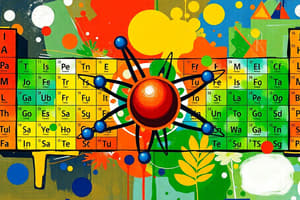Podcast
Questions and Answers
Which element has the ability to release energy when an electron is added, with an electron affinity of 27 KJ/mole (exo.)?
Which element has the ability to release energy when an electron is added, with an electron affinity of 27 KJ/mole (exo.)?
- Sulfur
- Oxygen
- Boron (correct)
- Fluorine
What is the opposite of electronegativity, which measures an element's ability to donate electrons?
What is the opposite of electronegativity, which measures an element's ability to donate electrons?
- Electron affinity
- Ionization energy
- Valence electron attraction
- Electropositivity (correct)
Why is oxygen more electronegative than nitrogen?
Why is oxygen more electronegative than nitrogen?
- Oxygen has 8 protons in the nucleus whereas nitrogen only has 7.
- Oxygen has 2 energy levels, while nitrogen has 3.
- The bonding electrons in nitrogen are further away from the nucleus of the atom.
- A bonding pair of electrons will experience more attraction from the oxygen’s nucleus than from nitrogen’s. (correct)
Why is oxygen more electronegative than sulfur?
Why is oxygen more electronegative than sulfur?
What happens to the atomic size as you move from left to right across a period?
What happens to the atomic size as you move from left to right across a period?
In which trend does electropositivity increase as the number of electron shells increases, resulting in less attraction between the nucleus and the valence electrons?
In which trend does electropositivity increase as the number of electron shells increases, resulting in less attraction between the nucleus and the valence electrons?
What is the trend for ionization energy as you move down a group?
What is the trend for ionization energy as you move down a group?
What is the definition of electron affinity?
What is the definition of electron affinity?
What happens to the electron affinity when an element is stable and has no ability to gain or lose electrons?
What happens to the electron affinity when an element is stable and has no ability to gain or lose electrons?
What is the relationship between the stability of an element and its ability to gain or lose electrons?
What is the relationship between the stability of an element and its ability to gain or lose electrons?
What happens to the atomic size as you move from left to right across a period?
What happens to the atomic size as you move from left to right across a period?
In which trend does ionization energies decrease?
In which trend does ionization energies decrease?
What is electron affinity?
What is electron affinity?
What is the difference between stable atom and unstable atom?
What is the difference between stable atom and unstable atom?
What is the relationship between the stability of an element and its ability to gain or lose electrons?
What is the relationship between the stability of an element and its ability to gain or lose electrons?
What is the measure of an element's ability to attract electrons towards itself in a compound?
What is the measure of an element's ability to attract electrons towards itself in a compound?
What is the electronegativity trend as you move from left to right across a period?
What is the electronegativity trend as you move from left to right across a period?
Which element has the highest electronegativity?
Which element has the highest electronegativity?
What is the relationship between the number of electron shells and electropositivity?
What is the relationship between the number of electron shells and electropositivity?
Why does oxygen have higher electronegativity than sulfur?
Why does oxygen have higher electronegativity than sulfur?
Flashcards are hidden until you start studying




